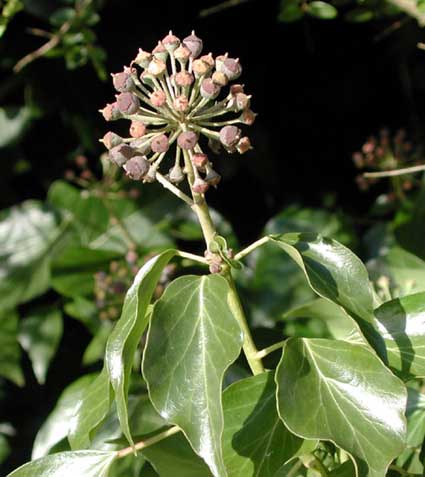
FLOWER OF THE MONTH - DECEMBER 2005
IVY (Hedera helix)

This common climber arouses conflicting passions like few other plants. It is not a parasite - it gets its nourishment from it roots - but it attaches itself to trees, walls, fences or any vertical surface so as to gain height. The typical "ivy-shaped" leaf is found only on the non-flowering shoots; the leaves of the flowering shoots are pointed but un-lobed (see the photograph). Ivy is strongly disliked by most foresters and tree-surgeons because, if left unchecked, it can smother even the tallest tree, and with its sheer weight it can cause the tree to collapse. It cans also damage buildings by locking gutters and eroding walls if the mortar is at all crumbly.
On the other hand, ivy is invaluable to wildlife. Its flowers, from September onwards, are loved by bees as a late source of nectar, and they are followed by black berries which are food for birds and mammals at a difficult time of the year. At all times it is a haven for small wildlife, insects, spiders and the like, and a roosting and nesting place for birds. It also provides useful fodder for farm animals.
It has been said to possess many qualities, for example, as a remedy for hangovers, or as a cure for verrucas and warts.
Ivy is also much appreciated for its decorative uses, especially by anyone with a taste for the picturesque or gothic - ivy covered ruins were the rage in Victorian days. Of course, it has long been used to "deck the hall" at Christmas.
"Save that from yonder ivy-mantled tower,
The moping owl does to the moon complain..."*
*Thomas Gray: "Elegy written in a Country Churchyard".
Notes by George Metcalfe. Photos by Colin Wootton.